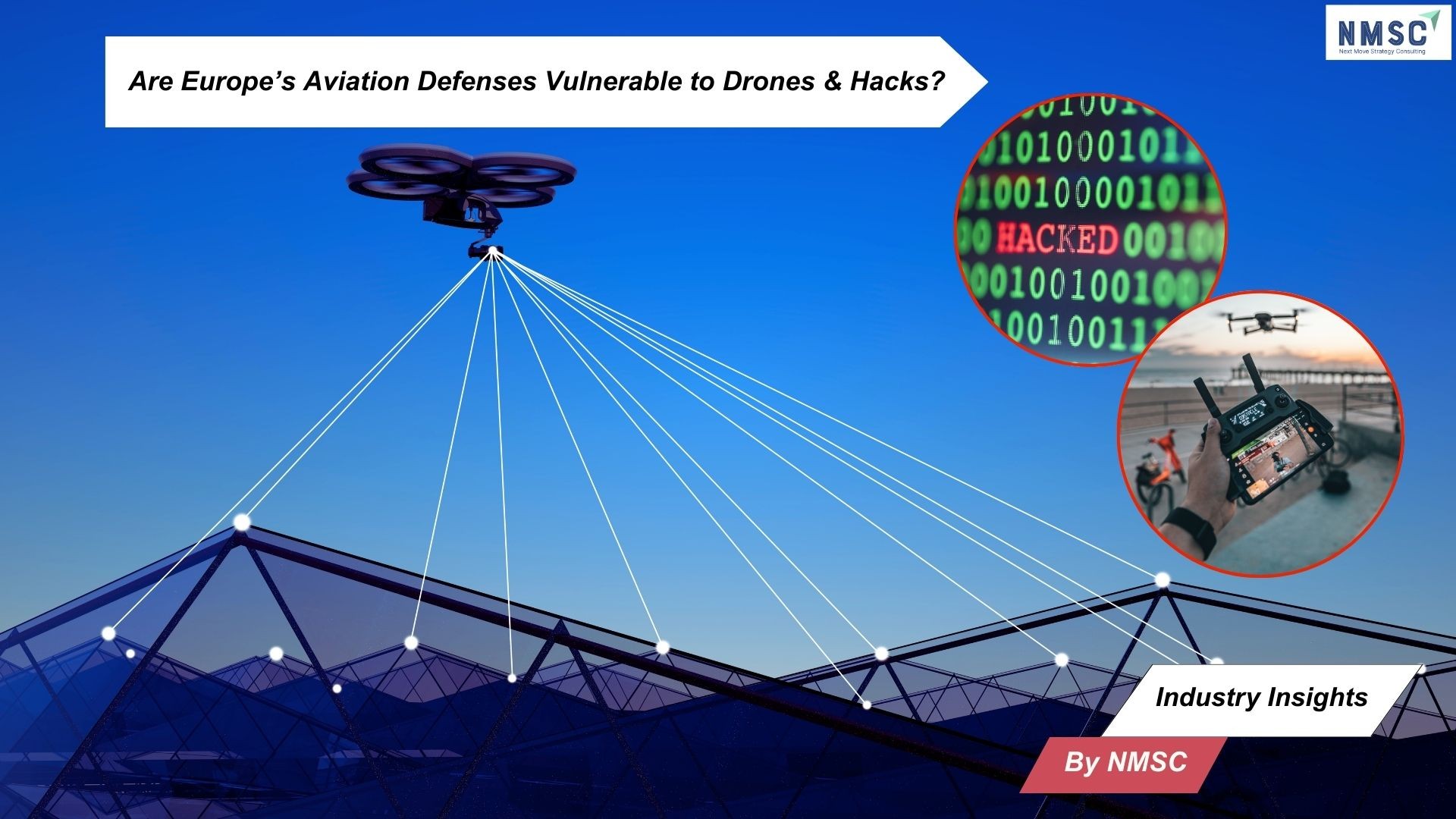Are Europe’s Aviation Defenses Vulnerable to Drones & Hacks?
Published: 2025-09-25

Industry Insights from Next Move Strategy Consulting
As Europe's aviation networks grapple with escalating hybrid threats, a series of drone incursions and a ransomware attack on key airport systems are illuminating critical weaknesses in the region's infrastructure. These events, spanning Denmark, Norway, and major hubs like London, Berlin, and Brussels, underscore the fragility of interconnected operations and the urgent need for robust countermeasures against evolving risks.
A Surge of Coordinated Disruptions Across Borders
The incidents began with unauthorized drone activity that grounded flights at Copenhagen Airport for hours on Monday, prompting Danish Prime Minister Mette Frederiksen to connect it to broader suspected Russian incursions disrupting European skies. A parallel event unfolded in Oslo, compounding the chaos just days after hackers targeted check-in systems via ransomware, affecting Europe's busiest gateway at London's Heathrow and facilities in Berlin and Brussels.
While investigators probe the origins, specialists view these as probing maneuvers within a wave of hybrid challenges designed to probe response mechanisms. "First is to test how the method works. In this case, it leads to closing down airports," noted Jukka Savolainen, network director at the European Centre of Excellence for Countering Hybrid Threats. "The second testing point is our reaction." Russia's ambassador to Denmark, Vladimir Barbin, dismissed involvement claims as baseless, and no independent verification has pinpointed perpetrators.
Highlighting Systemic Vulnerabilities in High-Stakes Operations
These breaches reveal the cascading effects of targeted interference, from supply chain outages to widespread flight delays and cancellations impacting hundreds of passengers. In an era of intensifying hybrid tactics—encompassing drones, GPS jamming, and digital intrusions—aviation stands out as particularly exposed due to its reliance on seamless connectivity for safety and efficiency.
"This attack shows just how vulnerable highly connected industries like aviation can be," observed Bart Salaets at U.S. cybersecurity firm F5, referencing the hack on Collins Aerospace software. Experts urge regulators to prioritize safeguards for cybersecurity, navigation integrity, and airspace management, especially amid heightened activities linked to potential state actors in recent weeks.
Calls for Proactive Measures and Infrastructure Overhauls
Aviation stakeholders, including airlines and airports, are pressing governments for decisive guidance as disruptions intensify. "(Drone activity) is getting worse and in my opinion, it won't stop," stated Eric Schouten, director of security intelligence and aviation advisory firm Dyami. "Airlines are looking at governments and authorities in this, airports the same." Moscow has repeatedly rejected any role in such actions, while Eurocontrol is aiding local controls with incident management support.
To build resilience, operators must adopt dynamic risk assessments, contingency plans for diversions, and layered mitigation strategies. "Operators need to be able to dynamically risk assess their operations, have plans in place for diverts and risk mitigation measures," advised Matthew Borie, intelligence officer at aviation security consultancy Osprey.
The Imperative to Elevate Security Standards
Yet, barriers persist: retrofitting airports with advanced tools like jammers, lasers, and detection trackers demands multimillion-dollar investments and lengthy implementations, deterring swift adoption amid fiscal constraints. The International Air Transport Association (IATA) highlights that counter-drone solutions remain nascent and often unaffordable for many facilities. For context, the U.S. Federal Aviation Administration logs over 100 monthly drone sightings near airports, mirroring trends now accelerating in Europe since Russia's 2022 invasion of Ukraine.
Jake Moore, an advisor at Slovakian cybersecurity firm ESET, emphasized the global ripple effects of supply chain breaches: "Regulators need to tighten standards even more for critical aviation IT suppliers. Whether this was a deliberate disruption attack, a financially motivated ransom or a major technical failure, the impact demonstrates how fragile such systems can be in a digitally focused world."
Implications for the Drone Market Amid Rising Threats – NMSC’s Viewpoint
These high-profile incidents are accelerating demand within the drone market, particularly for detection, neutralization, and regulatory compliance technologies. As airports and regulators confront persistent airspace intrusions, investments in scalable anti-drone systems—projected to surge with Europe's hybrid threat landscape—signal a pivotal growth phase.
Next Move Strategy Consulting (NMSC) anticipates that enhanced standards will drive market expansion, fostering innovation in integrated solutions that balance security with operational continuity, ultimately fortifying aviation's role in global connectivity.
Strengthening the Skies Against Emerging Risks
In the face of these probing disruptions, Europe's aviation community is at a crossroads, compelled to weave stronger fabrics of defense into its foundational operations. By embracing forward-looking standards and collaborative frameworks, the sector can transform vulnerabilities into fortified strengths, ensuring safer passage through an increasingly contested aerial domain.
Source: Reuters
Prepared by: Next Move Strategy Consulting
About the Author
 Sneha Chakraborty, a skilled SEO Executive and Content Writer with over 4 years in digital marketing, excels in boosting online visibility and engagement with data-driven strategies and compelling content. Passionate about simplifying digital ideas, she enjoys reading, sketching, and nature photography.
Sneha Chakraborty, a skilled SEO Executive and Content Writer with over 4 years in digital marketing, excels in boosting online visibility and engagement with data-driven strategies and compelling content. Passionate about simplifying digital ideas, she enjoys reading, sketching, and nature photography.
About the Reviewer
 Sanyukta Deb is a skilled Content Writer and Digital Marketing Team Leader, specializing in online visibility strategies and data-driven campaigns. She excels at creating audience-focused content that boosts brand presence and engagement, while also pursuing creative projects and design interests.
Sanyukta Deb is a skilled Content Writer and Digital Marketing Team Leader, specializing in online visibility strategies and data-driven campaigns. She excels at creating audience-focused content that boosts brand presence and engagement, while also pursuing creative projects and design interests.
















Add Comment